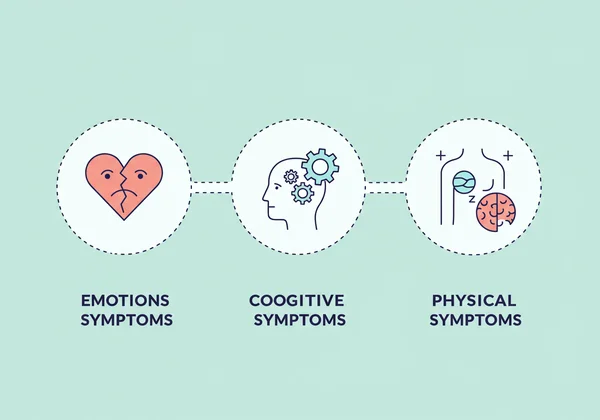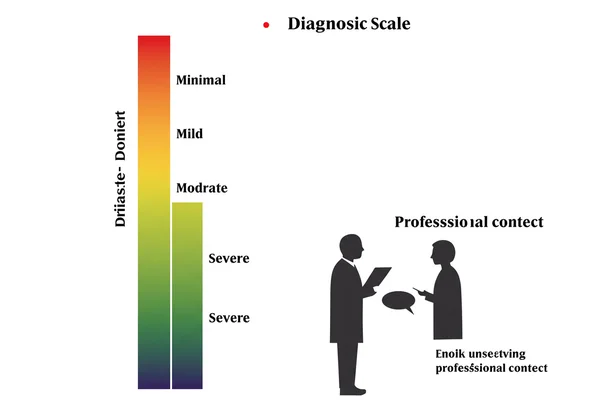BDI Test: Decoding the 21 Symptoms & Your Depression Score
Have you ever felt that your emotions were a tangled knot, too complex to unravel? You might know you feel "down" or "off," but putting a finger on the specifics can be difficult. The Beck Depression Inventory (BDI) is a powerful tool designed to bring clarity to this confusion. It goes beyond a simple number to provide a comprehensive picture of your mood. But what is the BDI test for? It’s designed to measure the intensity of 21 specific symptoms of depression, helping you understand your emotional landscape in a structured, meaningful way.
This guide will decode those 21 symptoms, revealing the science behind this respected self-assessment. Understanding how each question contributes to your overall score is the first step toward greater self-awareness. If you're ready to gain insight into your mood, you can take the free BDI test on our platform anytime.

What Does the BDI Test Measure? An Overview
The BDI is far more than just a questionnaire; it's a meticulously crafted scientific tool. Developed by Dr. Aaron T. Beck, it's one of the most widely used psychometric tests for measuring the severity of depression. What makes the BDI so powerful is its comprehensive view, understanding that depression impacts your mood, thoughts, body, and daily actions. The BDI test for depression provides a nuanced snapshot of your well-being over the past week.
Think of your emotional state as a detailed painting. A single score is just the title of the artwork, but understanding the 21 items is like examining each brushstroke. It reveals the texture, color, and depth that create the complete picture. This helps you move from a vague feeling of being unwell to identifying specific areas of challenge.
The Core Dimensions of Depression Explored by BDI
The Beck Depression Inventory's 21 questions are not arbitrary. They are carefully designed to assess three fundamental areas where depression often manifests:
-
Emotional Symptoms: These are the feelings most commonly associated with depression, such as persistent sadness, loss of pleasure, or feelings of worthlessness.
-
Cognitive Symptoms: This refers to your thought patterns. The BDI explores cognitive aspects like pessimism about the future, self-criticism, guilt, and difficulty making decisions.
-
Physical (Somatic) Symptoms: Depression is not all in your head. It has a real, physical impact. The test measures changes in sleep patterns, appetite, energy levels, and even your interest in sex.

How the 21 Items Form Your Overall BDI Score
The process of BDI scoring is straightforward and insightful. For each of the 21 items, you choose one of four statements that best describes how you've felt recently. These statements are graded on a scale from 0 (symptom is absent or minimal) to 3 (symptom is severe).
For example, for the symptom of 'Sadness', a score of 0 might be "I do not feel sad," while a 3 could be "I am so sad or unhappy that I can't stand it." Your total BDI score is the sum of the scores from all 21 questions, ranging from 0 to 63. This final number provides a quantitative measure of depression severity, but the real power comes from seeing which specific symptoms are contributing most to your score. Curious how your experiences align? You can start your self-assessment now.
A Deeper Look at Key BDI Items & Their Meaning
Let's break down the types of symptoms the BDI investigates. Seeing them grouped together can help you recognize patterns in your own experiences and better understand your BDI score meaning. Exploring the Beck Depression Inventory items is a direct path to personal insight.
Understanding Emotional & Motivational Symptoms (e.g., Sadness, Loss of Pleasure)
This category targets the core feelings associated with a depressive state. It includes questions about sadness, guilt, and feelings of being punished. A key symptom measured here is anhedonia—the inability to feel pleasure in activities you once enjoyed. This is a critical indicator that goes beyond simple sadness.
Have you noticed that your favorite hobbies or spending time with friends no longer bring you joy? This loss of pleasure, or anhedonia BDI measure, is a significant part of the BDI's assessment. It also explores motivational shifts, like a loss of interest in other people or your daily life.
Exploring Cognitive Symptoms (e.g., Self-Criticism, Guilt, Pessimism)
Depression profoundly impacts how you think about yourself, your life, and the world. The BDI dedicates several questions to these cognitive symptoms. It assesses tendencies toward self-criticism, where you might blame yourself for things that aren't your fault, or feel like a failure.
Pessimism, or a hopeless outlook on the future, is another key cognitive symptom. The test also measures indecisiveness, which can be paralyzing when you're struggling emotionally. These thought patterns can create a feedback loop that sustains a low mood, and identifying them is crucial for breaking the cycle.
Recognizing Physical & Behavioral Symptoms (e.g., Energy Loss, Sleep & Appetite Changes)
How you feel emotionally often shows up physically, and the BDI recognizes this. It assesses a range of physical symptoms. Are you sleeping much more or less than usual? Have you experienced significant changes in your appetite or weight?
Fatigue and loss of energy are hallmark physical symptoms of depression. You might feel exhausted even after a full night's sleep. The test also asks about irritability, as depression can sometimes manifest as frustration and a short temper rather than just sadness. These questions help create a complete picture of how your body is responding to your emotional state.

Addressing Suicidal Thoughts: A Critical Item and Resources
The BDI directly and responsibly addresses suicidal thoughts or wishes. This is a critical component of any comprehensive depression screening. It is vital to answer this question honestly, as it is a serious indicator of distress.
Disclaimer: If you are having suicidal thoughts, this test is not a substitute for immediate help. Please contact a crisis hotline or emergency services. In the US, you can call or text 988 anytime to connect with the Suicide & Crisis Lifeline. Your safety is the top priority.
This question is not meant to be alarming but to ensure that severe distress is recognized. Acknowledging these feelings is a brave first step toward getting the help you deserve.
Interpreting Your BDI Score: Beyond the Individual Symptoms
Once you complete the 21 questions, you'll receive a total score. This score is a helpful guide, but it's important to understand what it represents. To interpret BDI-II scores effectively is to see them not as a label, but as information. It's data that you can use to start a conversation, whether with yourself or with a healthcare professional.
Your score provides a valuable summary of your current state, but remember the painting analogy. The overall impression matters, but so do the individual brushstrokes—the specific symptoms that are causing you the most difficulty. If you're curious about your score, you can get your BDI score in minutes.
What BDI Score Ranges Indicate (Mild, Moderate, Severe Depression)
The total score from the BDI-II typically falls into several ranges, which correspond to different levels of depressive symptoms. While scoring can vary slightly, a commonly used guide is:
- 0-13: Minimal depression
- 14-19: Mild depression
- 20-28: Moderate depression
- 29-63: Severe depression
Seeing your score in the BDI mild moderate severe range can give you a framework for understanding your experience. For instance, a "moderate" score might encourage you to prioritize self-care and consider speaking with a therapist, while a "minimal" score might reassure you that your feelings, while valid, may not indicate a clinical issue.
The Importance of Self-Reflection and Professional Context
It is absolutely crucial to remember that the BDI test is a screening tool, not a diagnostic one. It cannot tell you if you have clinical depression. Only a qualified healthcare professional, like a doctor or psychologist, can provide a diagnosis after a comprehensive evaluation.
Use your results as a starting point for professional context and self-reflection. What patterns did you notice? Which symptoms resonated most strongly with you? This information can be incredibly valuable when you discuss your feelings with a professional. It gives them a clear, structured overview of your challenges, facilitating a more productive conversation.

Your Next Steps: Understanding BDI Symptoms for Better Self-Insight
Decoding the 21 symptoms of the BDI test empowers you with knowledge. You can move from a general feeling of being unwell to a specific understanding of the emotional, cognitive, and physical challenges you may be facing. This self-awareness is the foundation for making positive changes and seeking the right support.
Your journey to a richer life begins with simple exploration. By understanding the components of the BDI, you're already taking a significant step. The next is to apply that knowledge to your own life. Take the test now to receive your confidential score and a personalized starting point for your mental wellness journey.
Frequently Asked Questions About BDI Symptoms & Scoring
What is the BDI test designed to measure?
The BDI test is designed to measure the severity of depressive symptoms. It uses 21 questions to assess a person's mood, thoughts, and physical symptoms related to depression over the previous one to two weeks, providing a quantitative score to help gauge their current emotional state.
How do individual BDI questions contribute to the final score?
Each of the 21 questions has four answer choices, scored from 0 to 3 based on increasing severity. A user's final BDI score is the sum of the scores from all 21 questions. This means each question has an equal weight in contributing to the total score, which ranges from 0 to 63.
What do different BDI score ranges indicate about depression severity?
Generally, scores are interpreted as follows: 0-13 suggests minimal depression, 14-19 indicates mild depression, 20-28 points to moderate depression, and 29-63 signifies severe depression. These ranges help contextualize the results as a preliminary screening.
Is the BDI test a diagnostic tool for depression?
No, absolutely not. The BDI is a highly respected and scientifically valid screening tool, but it is not a diagnostic instrument. It can identify the presence and severity of depressive symptoms, but a formal diagnosis of clinical depression can only be made by a qualified mental health professional.
Where can I take a free BDI test online?
You can take a confidential and user-friendly version of the Beck Depression Inventory right here. Our platform provides a free BDI test online with instant results to help you gain valuable insight into your mood and well-being.